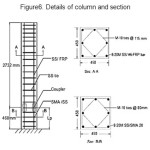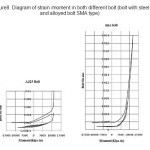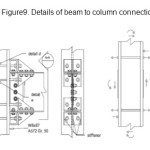The Shape Memory Alloys (SMA) Introducing and Evaluation of their Performance in Bending Moment Frame Connections
Saeed Jamalpour1 and Reza Jamalpour2 *
DOI: http://dx.doi.org/10.12944/CWE.10.Special-Issue1.33
B.M frames are responsible for absorbing earthquake energy by reaching their cross-sectional yield point and undergoing non-elastic deformations. this, in turn, causes permanent deformations in the frames, and occasionally restoration is impossible so that the whole structure might have to be disposed . The vulnerability of moment frame joints to lateral loadings and the need to improve their performance necessitates the use of materials capable of undergoing large and restorable deformations. Shape memory alloys are one type of such materials that have found use for this purpose. Because of their super-elastic property, these alloys are able to withstand non-elastic stresses and undergo large deformations, as well as to restore to their orginal configuration after being unloaded in the presence of the required conditions. In this paper these alloys will be introduced and their performance in moment frame joints will be studied..
Copy the following to cite this article:
Jamalpour S, Jamalpour R. The Shape Memory Alloys (SMA) Introducing and Evaluation of their Performance in Bending Moment Frame Connections. Special Issue of Curr World Environ 2015;10(Special Issue May 2015). DOI:http://dx.doi.org/10.12944/CWE.10.Special-Issue1.33
Copy the following to cite this URL:
Jamalpour S, Jamalpour R. The Shape Memory Alloys (SMA) Introducing and Evaluation of their Performance in Bending Moment Frame Connections. Special Issue of Curr World Environ 2015;10(Special Issue May 2015). Available from: http://www.cwejournal.org/?p=9
Download article (pdf) Citation Manager Publish History
Select type of program for download
| Endnote EndNote format (Mac & Win) | |
| Reference Manager Ris format (Win only) | |
| Procite Ris format (Win only) | |
| Medlars Format | |
| RefWorks Format RefWorks format (Mac & Win) | |
| BibTex Format BibTex format (Mac & Win) |
Article Publishing History
| Received: | 2015-02-20 |
|---|---|
| Accepted: | 2015-03-30 |
Introduction
Shape memory alloys are a group of alloys that can return to their initial shape and size when they subjected to a restoration process between two phases under the effect of a change in temperature. This phenomenon is named "Shape Memory". The basis on which these alloys behave is very simple so that when they subjected to a specific stress, strains and deformations will be happened , because of their special property, they can return to their original size (and shape) when a specific temperature is applied them (Ozbulut et al.,2011 ). The Figure-1 demonstrates the super-elastic effect and Figure-2 shows the shape memory phenomenon.
 |
Figure1: Super-elastic eff ect Click here to View figure |
 |
Figure2: Shape memory phenomenon Click here to View figure |
An important characteristic of these alloys that resulted usage of them increased in structural engineering is their super-elastic property. All materials utilized in structural engineering obey Hook's Law (elastic behavior) up to a certain point, however, so, when they subjected to a limit beyond their elastic limit, they will undergo plastic deformations. For example, the mild steel used in buildings behaves elastically up to 3% strain and beyond that the suffers plastic deformation will be happened, but in the same ,the shape memory alloys maintain their elastic behavior up to strains as large as 20% , and this behavior is called "super-elastic". Understanding the general behavior of materials partly requires knowledge of their crystalline structure. Shape memory alloys normally are stable in martensite and austenite phases. Generally, the martensite phase is stable in low temperatures and high stresses, whereas the austenite phase is stable in high temperatures in low stresses. Austenites have a cubic crystalline structure, whereas martensites have a trapezoidal one. The austenite phase is stable because of its symmetrical structure.
Significance of Issue
The most common structural systems which used in Iran are three-dimensional reinforced concrete bending moment frames (Jamalpour, Reza.,2010 ). Iran is a seismicity country and each decade and in any different regions, faced by devastating earthquakes (Jamalpour, Reza.,2011 ). These events and past experiences are showed a high seismic potential in most areas of the country. Given the fact that the trend in construction in Iran is toward the utilization of concrete structures, especially bending moment frames, and these structures are weak in the face of vibrational loading on their joints (Alam, M.S et al .,2008 ), and also joints connecting beams to columns in the mentioned structures play a critical role in their stability and performance, so, accurate design and implementation and the usage in the joints, of materials capable of undergoing increased deformation are necessary. The same is true about steel structures and steel moment frames (Sazmand et al .,2011 ). In case the usage of such materials in the mentioned structures is realized, a significant evolution will take place in the construction industry of the country with respect to the construction of building resistant in the face of earthquakes and guaranteeing the purports of standard No. 2800, and with respect to the increase in the service level of such structures, especially those of high importance (Building and Housing Research Center.,2005 ). Certainly in this direction, reducing the need to demolish the structures are affected by the earthquake, actually save a lot of building materials, energy, etc., in addition, this reduction will leads to a significant aid in the prevention of environmental pollution (Saeed jamalpour et al .,2011 )
Studies and Experiments on Concrete Frames
Alam et al (Alam, M.S et al .,2008 ) have conducted a seismic assessment of a connection of beam to column containing a shape memory alloy. They built a 3:4 scaled experimental model based on a structure previously computer-simulated. The mentioned structure was designed based on Canadian building code. Then, they computed the plastic joint length in the concrete beam using estimation formulas already provided. Afterward, they replaced the conventional rebar with shape memory alloys. Figure-3 demonstrates a detailed diagram of the constructed model.
 |
Figure3: Detailed diagram of the constructed model Click here to View figure |
After model verification, the hysteresis curve, shown in Figure-4, drawn for the joint. As seen in Figure-4 the curve representing the joint containing shape memory super elastic alloy (c) is thinner than that representing conventional rebar (a), however, the alloy undergoes much less plastic deformations in case of large strains. Therefore, joints containing such alloys contain better maintainability after an earthquake. Crack formation has been studied in the mentioned research as well with the result being that although initially maximum crack opening is bigger in joints containing a shape memory alloy than those containing rebar, after unloading the remaining opening (due to super-elastic behavior) in the former is smaller than the latter.
 |
Figure4: Hysteresis curve for connection normal steel (a), shape memory alloy(c) Click here to View figure |
Muntasir et al (. Muntasir et al .,2012) have studied the vibrational behavior of a reinforced concrete column containing shape memory alloy and FRP rebar. Figure-5 shows the mathematical model of the column and Figure-6 shows dimensions, cross-sectional geometry, and configuration of reinforcing members.
 |
Figure5: Mathematical model of the column Click here to View figure |
 |
Figure6: Details of column and section Click here to View figure |
Studies and Experiments on Steel Frames
Farzaneh & Qasemyh (Farzaneh, M et al .,2012) investigate the usage of shape memory alloys in the Steel Moment Connections. In connection with the bending steel bolt shape memory alloy instead of normal bolts. Fitting model in ANSYS software shown in Figure-7.
 |
Figure7: Connection model of software (ANSYS) Click here to View figure |
Finally, they concluded, the connections where the shape memory alloy bolts are used have a better performance compared to conventional bolt. Strain diagram against moment for both bolts in the connection can be seen in Figure-8. Speicher et al (. Matthew et al .,2011) investigated the use of shape memory alloys in reversible beam to column connection in steel structure. In this study, the authors examined the connections in which three types of tendon made of steel, shape memory alloy and super elastic shape memory alloy.
 |
Figure8: Diagram of strain /moment in both different bolt (bolt with steel A325 and alloyed bolt SMA type) Click here to View figure |
In Figures 9 and 10 shown the details of beam to
 |
Figure9: Details of beam to column connection Click here to View figure |
column connection and tendon which examined by mentioned authors. The tendons that are shape memory have higher formation and more energy depreciation and more return capability compered to tendons which are normal.
 |
Figure10: Details of used tendon Click here to View figure |
Using tendon in NITI type can return the deformation of connection into original form up to 85%. These types of tendons can perform like as viscous damper which amount of damping varies from 6 to 13%. Using single tendons that have higher damping compared to other tendons. If pre- train equal 0.5% imposes to tendon they show better behavior.
Discussion
Regarding to carried out investigation by different researchers in recent years that a few of them mentioned in this paper, the following conclusion can be drown about introducing , usage and the behavior of shape memory alloy.
- According to the authors and according to a new special and exceptional behavior of these materials, the Investigators and Structural Engineers approach to use of them in the laboratory research is considered a necessity in the country now.
- Due to high potential seismic of country and necessity of usage of important buildings in the event of a severe earthquake and needing to be in place after the earthquake and continue their serve and due to the weakness of such structures in the connections, the academic, scientific and research centers approach to use of these materials and their practical implementation of these materials in structures, is one of the most important affairs.
- According to studies and conducted tests, use of these materials where the structure has plastic strain (mainly connections), due to the elastic properties, has a tremendous effect in reducing the seismic response of structures.
- According to the direct relationship between weight and seismic response of structures, by reducing the structural response to seismic excitation energy and actually substantial absorbed and depreciation by these materials, the Procedure of structural design will tend to optimization and lightening.
- The usage of shape memory alloys are not limited to bars and reinforced concrete structures, they can used for any structure in which the special Specifications of these materials including large displacement ability, returning to original shape and Absorbing and dissipating the energy, are needed, it is possible to use them.
- The shape memory alloy can also be used in structures as the case of damper, and actually tendons are made of shape memory alloys act with a high damping coefficient such as viscous dampers.
- In the Case of large deformations or large cracks in concrete elements, usually reconstruction and Improvement of reinforced concrete structures with normal steel bar is not possible, but in these structures only and only with the creation of the necessary conditions (For example creation thermal conditions, etc., and create conditions for a transformational phase), the original shape of the materials can be easily obtained..
All Tables and figures must have a title or caption and a legend to make them self-explanatory. Results section shall start after materials and methods section on the same page.
References
- Ozbulut, O. E. Hurlebaus, S. and Desroches, R. (2011) "Seismic Response Control Using Shape Memory Alloys" Journal of Intelligent Material Systems and Structures, 5 August (2011).
- Jamalpour, Reza (2010)" Industrializing production and consumption of concrete in construction projects , causative of cement consumption patterns and sustainable development in country" 2end Iranian national conference of concrete, Tehran, Iran (2010).
- Jamalpour, Reza (2011)" The main challenges of crisis management in Karaj center of Alborz Province, due to the high capacity urban seismic vulnerability" 3th National Civil conference, Kurdistan, Iran(2011).
- Alam, M.S. Youssef, M.A. Nehdi, M. "Analytical prediction of the seismic behavior of super elastic shape memory alloy reinforced concrete elements", Engineering Structures 30 (2008) 3399_3411.
- Sazmand, E., Aghakochak A.K., Mazroei A. (2011) " Effect of Steel Moment Frames connection panel zone on the lateral behavior of steel bending moment frame with pair of profiles columns " Iranian Journal of steel and construction, (2011), p 2,3 .
- Building and Housing Research Center (2005) "Building classification according to importance , Group 1, Building with very High Importance" Iranian Code of Practice for Seismic Resistant Design of Buildings, Standard No. 2800 3th Edition p,6 .
- Saeed jamalpour, Reza Jamalpour, M .Peyrovi (2014) "Green environment and sustainable development, the result of cement conservation" Green Technologies and Sustainable Development in Construction, Advance Material Research, Trans Tech Publication, Switzerland, Vol. 935 (2014) pp. 323-328 .
- Muntasir, Billah A.H.M. Shahria, Alam M. (2012) "Seismic performance of concrete columns reinforced with hybrid shape memory alloy (SMA) and fiber Reinforced polymer (FRP) bars", Construction and Building Materials, 28 (2012) 730–742.
- Farzaneh, M. , Qasemieh, M. (2010) " Evaluating the use of shape memory alloys in steel moment connections" civil engineering conference , Islamic Azad University , Najafabad Branch (2010) ,Iran.
- Matthew, S. Speicher, Reginald. DesRoches, Leonb. Roberto, T. (2011) "Experimental results of a NiTi shape memory alloy (SMA)-based reentering beam-column connection", Construction and Building Materials, 33 (2011) 2448–2457







